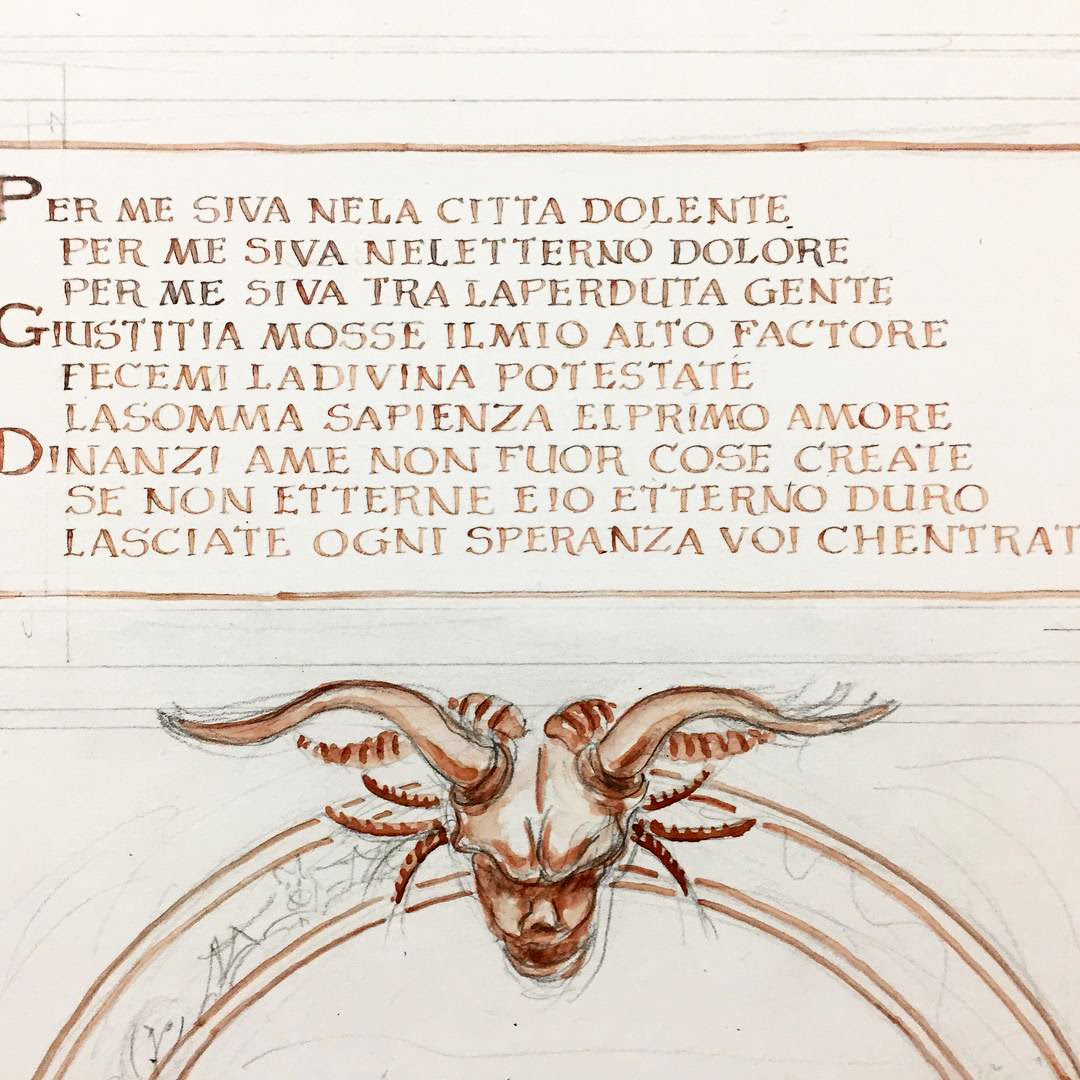The first fully hand-written, hand-illustrated version of the Divine Comedy since the 15th century
Seven hundred years after the death of Dante, we celebrate Dantedì with an interview to artist, illustrator and university professor George Cochrane, to learn more about his highly anticipated graphic novel version of the Divine Comedy, his passion for ‘all things Italian’ and his tips on how to learn the Italian language. It took him 20 years to understand Dante, and seven years to scribe all 350,000 characters, all three canticles, all 14,233 verses of the Divine Comedy. La Divina Commedia – The New Manuscript will be published in both Italian and English (Charles Singleton’s translation), following the Kickstarter campaign launched on March 16th, running until April 29th. And we can’t wait to get a copy!
180 tavole illustrate in stile graphic novel che riproducono esattamente la struttura de La Divina Commedia, capolavoro della letteratura italiana: tre cantiche (Inferno, Purgatorio, Paradiso) formate da 100 canti composti in terzine dantesche, stanze di tre versi di undici sillabe ciascuno, per un totale di più di 350.000 caratteri scritti a mano. Un volume che è anche una missione, quella di rendere il lavoro del Sommo Poeta accessibile a tutti e sottolinearne l’attualità. Dante è ancora qui.
1. Tell us about you, your career and your passions.

George Cochrane, next to Dante’s Bust Head statue
I was born in Fürt, Germany and I grew up in Dublin, New Hampshire until high school. Though I always drew, it was never the primary focus of my attention. My time was otherwise occupied reading, playing outdoor make-believe games, collecting insects, sailing, playing golf, building models, riding my bike from town to town, collecting records, acting in local theatre productions and much more.
I visited museums and churches everywhere I went, and picked up work as a dishwasher or an au pair to make ends meet. I lived in Oxford and Northampton, Paris, Amsterdam, Berlin and Florence, where I took an art history class at the Università di Firenze. In the four months before the school year began, I worked as an intern at the Peggy Guggenheim Museum in Venice and explored the Veneto. I saw Giotto in Padua for the first time. These experiences cemented my passion for all things Italian and were the next steps on my way to Dante.
After college, I settled into my life in New York City. I continued to paint and began to make my way. I worked as an art handler, galley preparator/installer, and studio assistant before returning to school to get my Masters of Fine Arts degree. I exhibited my paintings and drawings for years until I hit on a new idea: I would collaborate with my then 5-year-old daughter in creating an autobiographical graphic novel, Long Time Gone. The story is of a single day in our lives, modelled on Homer’s Odyssey.
In 2014, the publisher from Thornwillow Press in Newburgh, New York, saw that Dante was a character in my comic. He mentioned that the 700th anniversary of the poet’s death was coming in 2021. To mark the event, he suggested making a new edition using my handwritten comic font and featuring my artwork. Inferno, published in 2018, presents the canticle in a facing-page translation. T.W.P. declined to go forward with the publication of the entire Commedia. Undaunted, I continued, and I have been at work on the project ever since. After finishing Purgatorio, Facsimile Finder in San Marino decided to embrace the project and publish the finished work in 2021.
Music is my sustaining passion. From a young age, I have been an avid collector, amassing more than 10,000 LPs, 78-rpm discs, and CDs. Some of my favourite artists are Charlie Parker, Lester Young, Louis Armstrong, Bob Dylan, The Velvet Underground, The Fall, The Beatles, The Stooges and more.
For most of my life, I didn’t believe I could ever play music. That changed in 2018 when I started learning the guitar. That pursuit brings me joy every day.
2. In order to celebrate the genius of Dante, you decided to synthesize 700 years of art inspired by his poem into a single volume. What compelled you to start such an ambitious project?
I was moved to tackle this project because the opportunity to publish it came my way. It was an offer I couldn’t refuse. Without that impetus, I would have carried on creating Long Time Gone.
Once I began work, I took the same approach to the research as I did when making Long Time Gone: to learn and absorb as much of the subject’s history as I could, and then create the work informed by that knowledge. Comics have a 150-year history. For the Commedia, it is 700 years. I experienced the terror of trying to build on what Botticelli, Doré and many others had created. My anxiety diminished as I discovered great work by lesser-known artists such as Ebba Holm, Manfredo Manfredini and Antonio Grifo. My solution was to mix these sources, offering the reader echoes of both familiar and unfamiliar artwork.
3. Who are your favourite Italian authors? Which books do you recommend to our students and followers?
Dante, of course. I love Italo Svevo, Alberto Moravia, Natalia Ginzberg and Italo Calvino

La porta dell’inferno – vv. 1-9 hand-written and hand-illustrated
I read Moravia and Ginzburg as a student and they are great! They are an excellent place for the new Italian language reader to jump in. Written in a straightforward manner without complex vocabulary, these authors are accessible.
Calvino’s “Lezioni americane. Sei proposte per il prossimo millennio” was essential reading for me as a young artist. Composed at the end of his short life, it has the essence of Calvino delivered in just five lectures. Sadly, he died before completing the sixth. His thinking has altered my perception of reality.
I discovered Svevo via James Joyce and the NYC sculptor Richard Nonas. They both told me to read him. “La coscienza di Zeno” is a work of genius, and makes me laugh out loud. His language is perhaps a bit esoteric, but well worth the effort. Start with Zeno!
4. Are there Italian comic artists whom you admire and why?

Table from ‘Sulle Orme di Dante’ (On the footsteps of Dante), handwritten in English and Italian
Hugo Pratt is one of the greatest comic creators of all time. His thrilling adventure fumetti featuring “Corto Maltese” have all the narrative power he found in Milton Caniff’s “Terry and the Pirates.” His bravura artwork defines the word sprezzatura.
I read “Dylan Dog” whenever I can. Always a fun romp through the supernatural world. I always return from Italy with the latest. The series, in publication for many years, features the work of different artists and writers. I recently made a six-volume series of “Dante Dog” artist books. I borrowed from the comic and turned Dylan into Dante.
7. To better understand and translate to images the original text written by Sommo Poeta, you had to learn the Italian language. Do you have any study tips for ScuolaScuola’s students?
My story might be instructive. In high school (yes, back to that) I took a series of tests to determine my language aptitude. They told me I had none, and put me in a Latin class. For years, I believed them. But after my travels, I wanted to learn Italian. I studied it for the first time in college. I am sure that my year and a half of Latin helped at the start. Not everyone gets to study Latin anymore, but I am a huge fan. After two years in college, in Florence, I struggled mightily to speak or understand the language. I was determined, which for me, was the key. I refused to speak English. I tried not to care about what came out of my mouth. I hung out with Italian language speakers. In Florence, I lived with an Italian host family and we only spoke Italian in the house. Whenever I could, I avoided my lingua madre. That’s a challenge in Florence – so many American students. At least back then, we didn’t have smartphones constantly talking to us!

Dante’s portraits
My first suggestion will always be to go to Italy. Live there. Study there. Work as an au pair there. Do anything you can do to get there, and to stay for as long as you can (COVID-19 conditions/restrictions notwithstanding). Listen to Italian radio broadcasts and watch only Italian TV and movies. While studying in college I would watch Italian movies with subtitles in a TV viewing room in the library. This helped put the language in my ears. You can now do that on your iPhone. You can change your cell phone’s home language to Italian. When I was last in Italy driving around with an audible GPS, I set the language to Italian. That meant sometimes I missed my turn, but I learned how to give clear directions in the process!
Go to Italian opera! You can stream a great performance after getting to know the text. Subtitles are helpful, but eventually you need to turn them off, and let your brain have Italian thoughts first. I think it’s important to feel lost. When nothing you hear makes sense, your brain is actually working on comprehension. It happens slowly. Being patient is hard, but crucial. To me, language is ultimately about communication, which is always more than words alone. A speaker’s inflection, emphasis, body language, hand gestures all help us to understand her meaning, even without knowing all the words. If you learn a new word every day, you will start to see the word everywhere. It grows slowly, and then one day it clicks. I remember waking up and realizing that I had been dreaming in Italian. I did it, and you can too!
Interview by Caterina Micci
To learn more:
Facsimile Finder publishing
George Cochrane


